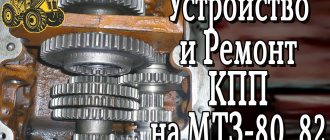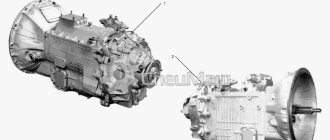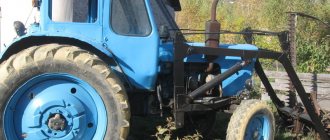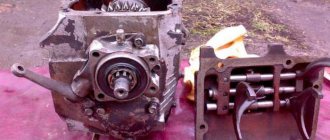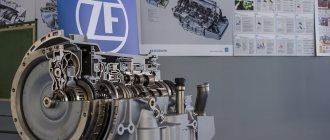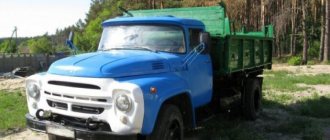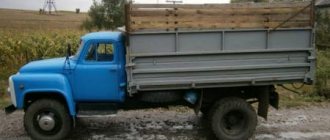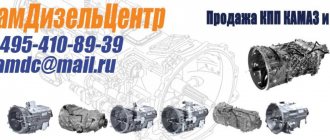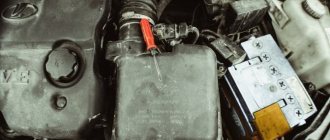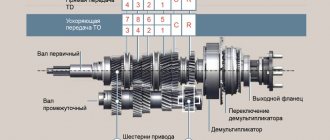What oils to use
In the 1960s there was not a wide variety of transmission fluids, so the manufacturer's recommendation was mineral oil, TAD-17. Even today it is poured into a box, but there is an alternative on the market.
Three types of transmission fluids are produced: mineral, semi-synthetic and synthetic. Synthetics are not suitable for ZIL-130, so fill in mineral or semi-synthetic. How much oil to fill in the ZIL gearbox - 5.1 liters. Which type to use - there are several options.
Mineral liquids
They contain additives that increase the life of the oil, improve its lubricating, cleaning, and anti-corrosion properties. “Mineral water,” for example, the same TAD-17, costs little, and does not contain harmful compounds. Due to additives, lubricant parameters are more stable under temperature changes. But you need to choose the right brand and type of oil; you will have to change it more often.
Semi-synthetics
It costs more than the mineral one, but it also surpasses it in characteristics. The liquid retains low viscosity in cold weather, and contains a complex of extreme pressure, detergent, and anti-foam additives. Oil life is longer. Owners of ZIL trucks fill in LUKOIL TM-5 85W-90 or a liquid with similar parameters.
Viscosity indicators
Manufacturers have developed three types of transmission fluid: winter, summer and all-season. They differ in viscosity index, which varies depending on the operating temperature. In summer, the oil should not become too liquid, otherwise the gaps will not seal, which will negatively affect the operation of the box and increase wear on its components. In winter, the fluid should not become excessively viscous - this complicates the operation of the synchronizers. Therefore, seasonal fluids have been developed and are changed every 6 months. If a truck owner wants to save himself the hassle, he buys all-season oil - provided that the truck operates in a region without a big difference between summer and winter temperatures.
SYNCHRONIZER
Synchronizers ensure silent operation when turned on. The difference in the rotation speed of the synchronizer clutch and the engagement of the gear is smoothly equalized due to the friction force that arises between them. The gearbox shift mechanism has a locking device that holds the shift rods in the required position.
Synchronizer ZIL-130
The synchronizer for LAZ-695, LAZ-697 buses and the ZIL-130 car (Fig. 132) works as follows.
When clutch 11 is moved to the left using the shift fork, the conical bronze ring will move with it and press against the conical surface of gear 1. The conical rings 7 and the clutch ]] are not connected rigidly to each other, but through three locking pins 5 with balls and a spring. Gear 1 and rings 7 rotate at different peripheral speeds. Until these speeds become equal due to the friction force, coupling 11 will shift (Fig. 132, b).
Synchronizer ZIL-130
Both bronze rings 7 are rigidly connected to each other using pins 12. The coupling 11 will move until the conical surface 10 of the coupling rests against the conical surface 9 of the pin (Fig. 132, a and d). When the speeds of the synchronizer rings 7 and the gear cone 1 are equalized, the pin 12 will be located in the center of the hole of the coupling 11, the blocking conical surfaces will separate (Fig. 132, c and d), and the coupling will continue its displacement. Its outer teeth 13 will engage with the inner teeth of the gear shaft 1, which will thus be connected via a synchronizer to the driven shaft 14.
Modernization
The cars, which were produced from 1964 to 1966, received carburetor engines with a power of 148 hp. With. The load capacity was up to 5 tons on asphalt or concrete, and up to 4 tons on primer, and the service life reached 135,000 km - before major repairs.
Modernization in 1966 gave the car a 150 hp engine, increased the service life to 200,000 km and the load capacity to 5 tons on any road. The changes did not affect how much oil is required in the ZIL gearbox.
The next modernization, which was carried out 10 years later, increased the load capacity of the dump truck to 6 tons and increased the service life to 300,000 km. Truck tractors were produced on the basis of the truck, which were used to tow trailers weighing 10-14.4 tons.
Synchronizer operation
When a synchronized gear is engaged, the following occurs: the synchronizer carriage 2 together with the fork 9 or 10 moves towards the gear being engaged. In this case, the movement of the carriage through three clamps is transmitted to the cone rings 3, which are rigidly connected to each other using three locking pins 1, until they stop at the gear cone.
Rice. Synchronizer device: 1 - locking finger; 2 - carriage; 3 - conical ring; 4 — clamp; 5 - spring; 6 - gear cone
Due to the difference in the peripheral speeds of the engaged elements (gear and synchronizer carriage) and the axial pressure transmitted through the clamps that hold the carriage from free axial movement, a friction moment occurs on the conical surfaces. Under the influence of the friction moment, the carriage shifts relative to the block of conical rings until it stops at the locking surface of the pins 1, which prevents the free axial movement of the carriage. As a result, the peripheral speeds of the switched elements are equalized (synchronization occurs).
After equalizing the peripheral speeds of the switched elements, the locking surfaces of the fingers will not interfere with the axial movement of the carriage and the selected gear will be engaged without noise or shock.
For normal operation of ZIL-130 synchronizers and to prevent premature wear of the rings, it is necessary to correctly and timely adjust the free play of the clutch pedal. If the clutch “leads”, changing gears becomes difficult. If synchronized gears are turned on with noise, the cause of the malfunction must be immediately found out and eliminated.
Features of the dump truck
The ZIL 130 model was designed and assembled at the Moscow Likhachev plant since 1964. The truck is immediately recognizable - the large cab, painted blue with a white front, is familiar to anyone over 30 years old.
The dump truck took 6 years to design, and at the time of release it was an innovative model with a spacious, comfortable cabin, power steering, synchronized gearbox, and an eight-cylinder four-stroke V-twin engine of 6 liters. The car received a heated engine and a glass washer - in those years this was a new product. The truck was also pleased with its efficiency - it is unpretentious in terms of fuel quality, consumes 30 liters per 100 km, and the filling volumes of the ZIL 130 are small. The dump truck turned out to be productive, durable, a real “hard worker”, which was more convenient to drive than previous ZIL models.
The medium-duty truck was not inferior to models from Europe and the USA. In 1973, the truck received the State Quality Mark, the award was well-deserved - hundreds of enterprises, farms and organizations sent thanks and reviews. In the fields, steppes, and conditions of the Far North, the ZIL 130 coped with its tasks perfectly.
Today, the loud, bumpy and tough old man is losing ground, giving way to modern trucks. But it is not written off - the unpretentiousness, ease of repair and endurance of the machine becomes an advantage where there are no high requirements for comfort or accuracy of cargo transportation.
ZIL-130 was produced at the Moscow plant until 1994. Afterwards, its production was transferred to the Ural AMUR plant, and until 2010 AMUR-531350 dump trucks rolled off the assembly line. The name is new, but the car is the same.
Replacement procedure
Regardless of how much oil is contained in the ZIL 130 bridge, the procedure for replacing it is the same. At the first stage, the old fluid is drained, after which the system is washed. Without flushing, remaining oxidation products and used additives will get into the new oil.
Washing is carried out with the same liquid that is planned to be poured into the box. Transformer and spindle oil are also used. During the washing process, the car is “rolled” at low speed and distance (200-300 m). The waste liquid is drained.
You already know how much oil to fill into the gearbox of a ZIL 130 - 5.1 liters. Now about the replacement procedure:
The oil change procedure is simple; it can be done even without visiting a car service center. But you need to remember that waste liquids are drained only into special containers - the oil is then sent for disposal. Draining it onto the ground or into bodies of water is strictly prohibited.
Instructions for lubrication of the ZIL-431410 car
Car maintenance involves using only those oils and lubricants recommended by the factory.
The service life of a vehicle largely depends on the timely and correct implementation of the lubrication operation, as well as on the types, quality and purity of the oils used.
When using oils with additives for linear motors, the service life of such oils can be increased (by mileage) by approximately 1.5 times. The use of oils without additives for V-shaped engines is not allowed.
Accurate adherence to all vehicle lubrication instructions is mandatory. The use of oils and lubricants not listed in the table, as well as violation of lubrication schedules, are not allowed. In the lubrication tables, along with the main oil, the names of substitute oils are given. The use of substitutes reduces the durability of the units and also increases the labor costs for replacing them, since their service life in the units is shorter.
Vehicles must be lubricated during maintenance (TO-1 and TO-2) in accordance with the lubrication table.
It is necessary to drain the oil from the units when replacing it immediately after stopping the car, when the units are warmed up. When draining the oil, it is necessary to clean the magnets of the drain plugs. You cannot fill cars with cold oil with high viscosity. The oil must be heated before refueling.
Before lubricating car components through grease nipples, you must thoroughly clean them of dirt; after lubrication, you must remove all grease that has come out from the parts.
After driving a vehicle through a ford or working in water for a long time, it is necessary to check whether water has entered the units. If water is detected in the engine or other units, it is necessary to drain the old oil and fill in new oil.
Table B. 1 – Chemical map of the ZIL-431410 car and its modification
| Number in the picture | Mechanism name | Name of operating materials (GOST, TU) | Lubricant quantity | Frequency of replacement of operating materials | Note | ||
| Basic | Duplicate | 1100-2300 km (TO-1) | 5500-9200 km (TO-2) | Other services) | |||
| Engine | Gasoline A-76 GOST 2084-77 | Gasoline AI-80 GOST R51105-97 | 31 l/100 km | ||||
| 1.1 | Engine crankcase with oil cooler on | M-8-V1, M-6z/10-V1 GOST 17479.1-85 | SAE-10, SAE-20, (at t from 0 to -12º C) | ||||
| Engine speed limiter sensor | M-8-V1, M-6z/10-V1 GOST 17479.1-85 | SAE-10, SAE-20, | A few drops (1 dot) | ||||
| Distributor | M-8-V1, M-6z/10-V1 GOST 17479.1-85 | SAE-10, SAE-20, | A few drops (3 dots) | ||||
| 3.1 | Distributor drive roller | Grease 113C GOST 6267-74 | Litol-24 GOST 21150-87 | As needed (1 point) | – | + | – |
| Engine air filter | M-8-V1, M-6z/10-V1 GOST 17479.1-85 | SAE-10, SAE-20 | 0.63 l (1 point) | – | – | – | In very dusty conditions, change the oil every other day. |
Continuation of Table B.1
| Crankcase ventilation air filter | M-8-V1, M-6z/10-V1 GOST 17479.1-85 | SAE-10, SAE-20 | 0.07 l (1 point) | – | + | – | Same | |
| Water pump bearings | Grease 113C GOST 6267-74 | Litol-24 GOST 21150-87 | 0.215 kg (1 point 11:53a) | – | – | + | ||
| Generator bearings | Grease 113C GOST 6267-74 | Litol-24 GOST 21150-87 | As needed (2 points) | – | – | + | After 75,000 km | |
| Clutch fork bushings | Solid oil S GOST 3333-80 | Solid oil ZH GOST 3333-80 | -//- | – | + | – | Add grease until fresh grease appears. | |
| – | Clutch pedal axle bushings | -//- | -//- | -//- | – | + | – | Same |
| Gearbox housing | TM-3-18 (TAp-15V) In winter TM-4-18 (TSp-14); GOST 17479.2-85 | TM-3-9 (TSp10); GOST 17479.2-85 SAE-80 at temperatures below 0ºС, SAE-90 at temperatures from 0º to 32ºС, SAE-140 at temperatures above 32ºС | 5.1 (1 point) | – | – | + | ||
| Cardan joint needle bearings | Grease 158S GOST 20421-75 | Grease CIATIM-201 GOST 6267-74 | As needed (3 points) | – | + | – | ||
| Cardan shaft splines | Grease 113C GOST 6267-74 | Litol-24 GOST 21150-87 | 0.20 kg (1 point) | – | – | + | After 15,000-27,000 km, remove the spline bushing, remove the old grease and apply new one |
Continuation of Table B.1
| Rear axle gear housing | TM-3-18, TM-4-18 GOST 17479.2-85 | TM-3-9 GOST 17479.2-85, SAE-90, SAE-140 | 4.5 kg (1 point) | – | – | + | During TO-2, check the oil level, flush the breather air channels and add oil to the level of the control plug | |
| Cardan shaft intermediate support bearing | Grease 113C GOST 6267-74 | Litol-24 GOST 21150-87 | 0.04 kg (1 point) | – | – | + | Lubricate after 2200-4600 km | |
| Power steering and steering mechanism | Oil grade “R” TU 38.101.179-71 | Type A oil for automatic transmissions | 2.75 l (1 point) | + | – | – | When using a substitute oil, change the oil twice a year (spring and autumn) | |
| Steering column propeller shaft joints | Grease 158S GOST 20421-75 | Grease CIATIM-201 GOST 6267-74 | 1.0-1.2 g each (2 points) | – | – | + | ||
| 15.1. | Steering bipod driveshaft splines | Grease 113C GOST 6267-74 | Litol-24 GOST 21150-87 | -//- (1 point) | – | – | + | Once a year, disassemble the shaft, remove old grease and lubricate the splines with fresh grease. |
Continuation of Table B.1
| Tie rod joint | Solid oil of any brand GOST 3333-80 | – | -//- (4 points) | + | – | – | Lubricate the hinges using a grease nipple. |
| Steering pins | -//- | – | -//- (4 points) | + | – | – | Same |
| Front and rear suspension pins | -//- | – | -//- (4 points) | + | – | – | Same |
| Telescopic shock absorbers | Shock absorption fluid AZh-12 GOST 57388-78 | – | -0.41 l (2 points) | – | – | + | Replacement after 25,000-30,000 km, but at least once a year |
| Front axle wheel bearings | Grease 113C GOST 6267-74 | Litol-24 GOST 21150-87 | 0.5 kg (2 points) | – | – | + | Change after 10,000-18,000 km |
| 20.1 | Rear axle wheel bearings | Grease 113C GOST 6267-74 | Litol-24 GOST 21150-87 | 1.0 kg (2 points) | – | – | + |
| Worm pairs of wheel brake adjusting levers | Solid oil S GOST 3333-88 | Solid oil ZH GOST 3333-88 | 0.18 kg (4 points) | – | – | + | Add lubricant every 10,000-18,000 km |
| Expansion fist shafts | Solid oil S GOST 3333-88 | Solid oil ZH GOST 3333-88 | As needed (6 points) | + | – | – | |
| Towing hook stem | Solid oil of any grade GOST 3333-88 | – | The same (2 points) | + | – | – | Lubricate after 5000-9000 km |
| Pawl pins and towing hook latches | M-8-V1, M-6z/10-V1 GOST 17479.1-85 | SAE-10, SAE-20 | A few drops (2 dots) | + | – | – | Same |
| Door hinges | M-8-B1, M-8-V1, M-6z/10-V1 GOST 17479.1-85 | SAE-10, SAE-20 | As needed (4 points0 | – | – | + | Lubricate after 2000-3600 km |
